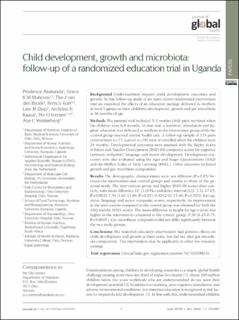| dc.contributor.author | Atukunda, Prudence | |
| dc.contributor.author | Muhoozi, Grace Kyamazima Mehangye | |
| dc.contributor.author | van den Broek, Tim | |
| dc.contributor.author | Kort, Remco | |
| dc.contributor.author | Diep, Lien My | |
| dc.contributor.author | Kaaya, Archileo | |
| dc.contributor.author | Iversen, Per Ole | |
| dc.contributor.author | Westerberg, Ane Cecilie | |
| dc.date.accessioned | 2022-10-20T08:30:15Z | |
| dc.date.available | 2022-10-20T08:30:15Z | |
| dc.date.created | 2019-07-14T07:45:25Z | |
| dc.date.issued | 2019 | |
| dc.identifier.citation | Journal of Global Health. 2019, 9 (1), 1-11. | en_US |
| dc.identifier.issn | 2047-2978 | |
| dc.identifier.uri | https://hdl.handle.net/11250/3027227 | |
| dc.description.abstract | Background Undernutrition impairs child development outcomes and growth. In this follow-up study of an open cluster-randomized intervention trial we examined the effects of an education package delivered to mothers in rural Uganda on their children’s development, growth and gut microbiota at 36 months of age. Methods The parental trial included 511 mother-child pairs recruited when the children were 6-8 months. In that trial, a nutrition, stimulation and hygiene education was delivered to mothers in the intervention group while the control group received routine health care. A follow-up sample of 155 pairs (intervention n = 77, control n = 78) were re-enrolled when the children were 24 months. Developmental outcomes were assessed with the Bayley Scales of Infant and Toddler Development (BSID-III) composite scores for cognitive (primary endpoint), language and motor development. Development outcomes were also evaluated using the Ages and Stages Questionnaire (ASQ) and the Mullen Scales of Early Learning (MSEL). Other outcomes included growth and gut microbiota composition. Results The demographic characteristics were not different (P > 0.05) between the intervention and control groups and similar to those of the parental study. The intervention group had higher BSID-III scores than controls, with mean difference 10.13 (95% confidence interval (CI): 3.31-17.05, P = 0.002); 7.59 (1.62-13.66, P = 0.01); 9.00 (2.92-15.40, P = 0.005), for cognitive, language and motor composite scores, respectively. An improvement in the intervention compared to the control group was obtained for both the ASQ and the MSEL scores. The mean difference in height-for-age z-score was higher in the intervention compared to the control group: 0.50 (0.25-0.75, P = 0.0001). Gut microbiota composition did not differ significantly between the two study groups. Conclusions The maternal education intervention had positive effects on child development and growth at three years, but did not alter gut microbiota composition. This intervention may be applicable in other low-resource settings. | en_US |
| dc.description.sponsorship | The study was supported by the Throne Holst Foundation, the University of Oslo and TNO’s Early Research Program “Personalized Health”. | en_US |
| dc.language.iso | eng | en_US |
| dc.rights | Navngivelse 4.0 Internasjonal | * |
| dc.rights.uri | http://creativecommons.org/licenses/by/4.0/deed.no | * |
| dc.title | Child development, growth and microbiota: follow-up of a randomized education trial in Uganda | en_US |
| dc.type | Peer reviewed | en_US |
| dc.type | Journal article | en_US |
| dc.description.version | publishedVersion | en_US |
| dc.source.pagenumber | 1-11. | en_US |
| dc.source.volume | 9 | en_US |
| dc.source.journal | Journal of Global Health | en_US |
| dc.source.issue | 1 | en_US |
| dc.identifier.doi | 10.7189/jogh.09.010431 | |
| dc.identifier.cristin | 1711408 | |
| cristin.unitcode | 1615,40,10,0 | |
| cristin.unitname | Institutt for helsevitenskap | |
| cristin.ispublished | true | |
| cristin.fulltext | original | |
| cristin.qualitycode | 1 | |

